Binomial theorem
Binomial Expansion Formulas
Before learning binomial expansion formulas, let us recall what is a "binomial". A binomial is an algebraic expression with two terms. For example, a + b, x - y, etc are binomials. We have a set of algebraic identities to find the expansion when a binomial is raised to exponents 2 and 3. For example, (a + b)2 = a2 + 2ab + b2. But what if the exponents are bigger numbers? It is tedious to find the expansion manually. The binomial expansion formula eases this process. Let us learn the binomial expansion formula along with a few solved examples.
What Are Binomial Expansion Formulas?
As we discussed in the earlier section, the binomial expansion formulas are used to find the powers of the binomials which cannot be expanded using the algebraic identities. The binomial expansion formula involves binomial coefficients which are of the form (or) and it is calculated using the formula, =n! / [(n - k)! k!]. The binomial expansion formula is also known as the binomial theorem. Here are the binomial expansion formulas.
Binomial Theorem
There are several closely related results that are variously known as the binomial theorem depending on the source. Even more confusingly a number of these (and other) related results are variously known as the binomial formula, binomial expansion, and binomial identity, and the identity itself is sometimes simply called the "binomial series" rather than "binomial theorem."
The most general case of the binomial theorem is the binomial series identity
 | (1) |
where is a binomial coefficient and
is a real number. This series converges for
an integer, or
. This general form is what Graham et al. (1994, p. 162). Arfken (1985, p. 307) calls the special case of this formula with
the binomial theorem.
When is a positive integer
, the series terminates at
and can be written in the form
 | (2) |
This form of the identity is called the binomial theorem by Abramowitz and Stegun (1972, p. 10).
The differing terminologies are summarized in the following table.
| "binomial theorem" | source |
| Graham et al. (1994, p. 162) | |
| Arfken (1985, p. 307) | |
| Abramowitz and Stegun (1972, p. 10) |
The binomial theorem was known for the case by Euclid around 300 BC, and stated in its modern form by Pascal in a posthumous pamphlet published in 1665. Pascal's pamphlet, together with his correspondence on the subject with Fermat beginning in 1654 (and published in 1679) is the basis for naming the arithmetical triangle in his honor.
Newton (1676) showed the formula also holds for negative integers ,
 | (3) |
which is the so-called negative binomial series and converges for .
In fact, the generalization
 | (4) |
holds for all complex with
.
Among his many other talents, Major General Stanley in Gilbert and Sullivan's operetta the Pirates of Penzance impresses the pirates with his knowledge of the binomial theorem in "The Major General's Song" as follows: "I am the very model of a modern Major-General, I've information vegetable, animal, and mineral, I know the kings of England, and I quote the fights historical, From Marathon to Waterloo, in order categorical; I'm very well acquainted too with matters mathematical, I understand equations, both the simple and quadratical, About binomial theorem I'm teeming with a lot o' news-- With many cheerful facts about the square of the hypotenuse."
The Binomial Theorem In Action
Let’s begin with a straightforward example, say we want to multiply out (2x-3)³. This wouldn’t be too difficult to do long hand, but let’s use the binomial theorem so that when you encounter larger expansions such as binomials raised to the 4, 5, 6, … powers you’ll know exactly what to do.
To get started, you need to identify the two terms from your binomial (the x and y positions of our formula above) and the power (n) you are expanding the binomial to.
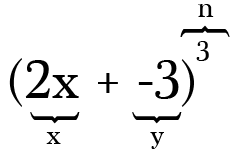
For example, to expand (2x-3)³, the two terms are 2x and -3 and the power, or n value, is 3. Note that whenever you have a subtraction in your binomial it’s oh so important to remember to include the minus as a negative symbol on the accompanying term.
The wonderful thing about the binomial theorem is it allows us to find the expanded polynomial without multiplying a bunch of binomials together. Pretty neat, right? It turns out that the number of terms in your expanded polynomial will always be one more than the power you’re expanding. That means we’ll be creating a polynomial with 4 terms since the power in this example is 3.
Each term will have a (2x) and (-3) as well as the “n choose k” formula where n=3. You can go ahead and write that down 4 times, one for each term, leaving the k value in “n choose k” and the powers blank for the moment.
Next you’ll want to fill in the k-values and powers. Here you can follow the summation formula, increasing the power for each term. But it is pretty easy to just follow the patterns.
The k values in “n choose k”, will begin with k=0 and increase by 1 in each term. The last term should end with n equal to k, in this case n=3 and k=3.
Next we need to add the powers onto (2x) and (-3).
The power on (2x) will begin with the n-value, so in this case 3, and will decrease by 1 on each term, until you get to zero. The power on (-3) will start with zero and increase by one each time until you get to n, or 3 in this problem.

Because any value raised to the zero power equals 1, you can simplify the terms with powers of zero.

Next go ahead and apply the powers and simplify wherever possible.

The Pascal’s Triangle Shortcut

The last part is to solve the combinations formula. The obvious way to do this is to apply the combinations formula for each problem. But we’re going to take a nice little shortcut here using Pascal’s Triangle.
Pascal’s Triangle is a simple, but powerful triangle formed by creating a triangle with three 1’s to begin. For each row thereafter you simply write 1’s on both ends, and find the middle number(s) by adding the two values from directly above it.

Now here’s the good part. Hidden within Pascal’s Triangle are all the answers to any “n choose k”! It’s like a secret little cheatsheet!
The diagram below shows you where the hidden “n choose k’s” are located.
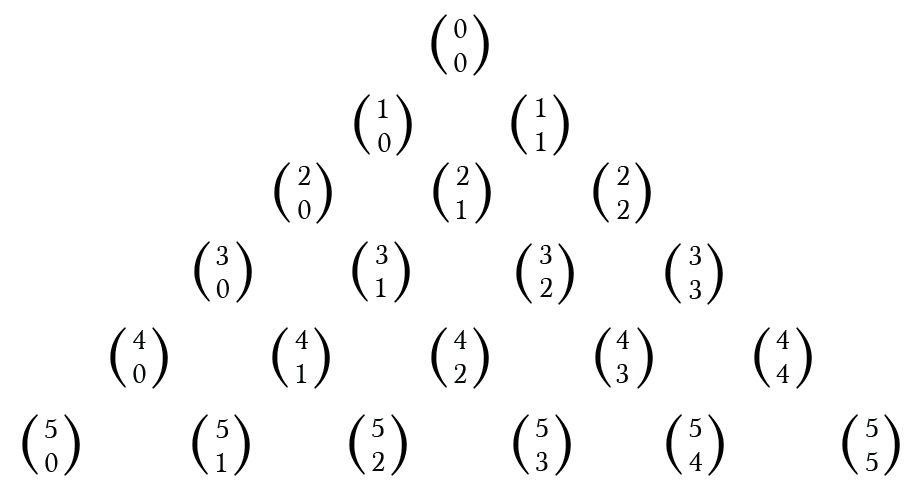
For our problem we need to solve for: 3 choose 0, 3 choose 1, 3 choose 2, and 3 choose 3. Which is all the values in the 4th row. So all we need to do is look to the 4th row of Pascal’s Triangle and match up the answers.
The 4th row has the values: 1, 3, 3, 1. So I’ll just substitute in the answers for our n choose k’s.

Lastly, all you need to do is multiply and simplify each term down to it’s simplest form. Don’t forget to check your final answer to make sure the powers on each term still add to the degree of your original binomial! Trust me, it’s incredibly easy to make a transcription error in this type of problem ;)
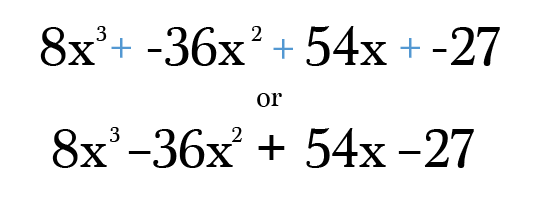
Need another example?
s I show you some additional tricks for staying organized and a couple quick checks you can use to easily identify common errors.
Thanks for reading!
Binomial Expansion Formula of Natural Powers
This binomial expansion formula gives the expansion of (x + y)n where 'n' is a natural number. The expansion of (x + y)n has (n + 1) terms. This formula says:
(x + y)n = nC xn y0 + nC xn - 1 y1 + nC xn-2 y2 + nC xn - 3 y3 + ... + nC x yn - 1 + nC x0yn
Here we use nC formula to calculate the binomial coefficients which says nC = n! / [(n - k)! k!]. By applying this formula, the above binomial expansion formula can also be written as,
(x + y)n = xn + n xn - 1 y1 + [n(n - 1)/2!] xn-2 y2 + [n(n - 1)(n - 2)/3!] xn - 3 y3 +... + n x yn - 1 + yn
Note: If we observe just the coefficients, they are symmetric about the middle term. i.e., the first coefficient is the same as the last one, the second coefficient is as same as the one that is second from the last, etc.
Binomial Expansion Formula of Rational Powers
This binomial expansion formula gives the expansion of (1 + x)n where 'n' is a rational number. This expansion has an infinite number of terms.
(1 + x)n = 1 + n x + [n(n - 1)/2!] x2 + [n(n - 1)(n - 2)/3!] x3 +...
Note: To apply this formula, the value of |x| should be less than 1.
Eamples Using Binomial Expansion Formulas
Have questions on basic mathematical concepts?
Example 1: Find the expansion of (a + b)3.
Solution:
To find: (a + b)3
Using binomial expansion formula,
(x + y)n = nC xn y0 + nC xn - 1 y1 + nC xn-2 y2 + nC xn - 3 y3 + ... + nC x yn - 1 + nC x0yn
(a + b)3 = 3C a3 + 3C a(3 - 1) b + 3C a(3 - 2) b2 + 3C a(3 - 3) b3
= ( 3! / [(3-0)!0!] ) a3 + ( 3! / [(3-1)!1!] ) a(3 - 1) b + ( 3! / [(3-2)!2!] ) a(3 - 2) b2 + ( 3! / [(3-3)!3!] ) a(3 - 3) b3
= (1) a3 + (3) a2 b + (3) a1 b2 + (1) a0b3
= a3 + 3a2 b + 3ab2 + b3
Answer: (a + b)3 = a3 + 3a2 b + 3ab2 + b3.
Example 2: Find the expansion of (x + y)6.
Solution:
Using the binomial expansion formula,
(x + y)n = nC xn y0 + nC xn - 1 y1 + nC xn-2 y2 + nC xn - 3 y3 + ... + nC x yn - 1 + nC x0yn
(x + y)6 = 6C x6 + 6C x5 y + 6C x4y2 + 6C x3y3 + 6C x2y4 + 6C xy5 + 6C y6
= ( 6! / [(6-0)!0!] ) x6 + ( 6! / [(6-1)!1!] ) x5 y + ( 6! / [(6-2)!2!] ) x4y2 + ( 6! / [(6-3)!3!] ) x3y3 + ( 6! / [(6-4)!4!] ) x2y4 + ( 6! / [(6-5)!5!] ) xy5 + ( 6! / [(6-6)!6!] ) y6
= x6 + 6x5 y + 15x4 y2 + 20x3 y3 + 15x2 y4 + 6x y5 + y6
Answer: (x + y)6 = x6 + 6x5 y + 15x4 y2 + 20x3 y3 + 15x2 y4 + 6x y5 + y6.
Example 3: Find the expansion of (3x + y)1/2 upto the first three terms using the binomial expansion formula of rational exponents where < 1.
Solution:
(3x + y)1/2 = 3x (1 + y/(3x))1/2
Comparing (1 + y/(3x))1/2 with (1 + x)n, we have x =y/(3x) and n = 1/2.
The expansion of (1 + y/(3x))1/2 upto the first three terms using the binomial expansion formula is,
1 + n x + [n(n - 1)/2!] x2 = 1 + (1/2) (y / (3x)) + [(1/2) ((1/2) - 1)/2!] (y / (3x))2
= 1 + y / (6x) - y2 / (72x2)
Thus, the expansion of 3x (1 + y/(3x))1/2 upto the first three terms is:
3x [ 1 + y / (6x) - y2 / (72x2) ] = 3x + y / 2 - y2 / (24x)
Answer: (3x + y)1/2 = 3x + y / 2 - y2 / (24x).
binomial theorem, statement that for any positive integer n, the nth power of the sum of two numbers a and b may be expressed as the sum of n + 1 terms of the form

A binomial is a polynomial with two terms
 |
| example of a binomial |
What happens when we multiply a binomial by itself ... many times?
The calculations get longer and longer as we go, but there is some kind of pattern developing.
That pattern is summed up by the Binomial Theorem:

The Binomial Theorem
Don't worry ... it will all be explained!
And you will learn lots of cool maths symbols along the way.
Exponents
First, a quick summary of Exponents.
An exponent says how many times to use something in a multiplication.
An exponent of 1 means just to have it appear once, so we get the original value:
An exponent of 0 means not to use it at all, and we have only 1:
Exponents of (a+b)
Now on to the binomial.
We will use the simple binomial a+b, but it could be any binomial.
Let us start with an exponent of 0 and build upwards.
Exponent of 0
When an exponent is 0, we get 1:
(a+b)0 = 1
Exponent of 1
When the exponent is 1, we get the original value, unchanged:
(a+b)1 = a+b
Exponent of 2
An exponent of 2 means to multiply by itself (see how to multiply polynomials):
(a+b)2 = (a+b)(a+b) = a2 + 2ab + b2
Exponent of 3
For an exponent of 3 just multiply again:
(a+b)3 = (a2 + 2ab + b2)(a+b) = a3 + 3a2b + 3ab2 + b3
We have enough now to start talking about the pattern.
The Pattern
In the last result we got:
a3 + 3a2b + 3ab2 + b3
Now, notice the exponents of a. They start at 3 and go down: 3, 2, 1, 0:

Likewise the exponents of b go upwards: 0, 1, 2, 3:

If we number the terms 0 to n, we get this:
| k=0 | k=1 | k=2 | k=3 |
| a3 | a2 | a | 1 |
| 1 | b | b2 | b3 |
Which can be brought together into this:
an-kbk
How about an example to see how it works:
Coefficients
We are missing the numbers (which are called coefficients).
Let's look at all the results we got before, from (a+b)0 up to (a+b)3:
And now look at just the coefficients (with a "1" where a coefficient wasn't shown):
They actually make Pascal's Triangle! Each number is just the two numbers above it added together (except for the edges, which are all "1")(Here I have highlighted that 1+3 = 4) | 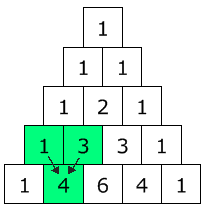 |
Armed with this information let us try something new ... an exponent of 4:
| a exponents go 4,3,2,1,0: | a4 | + | a3 | + | a2 | + | a | + | 1 | ||
| b exponents go 0,1,2,3,4: | a4 | + | a3b | + | a2b2 | + | ab3 | + | b4 | ||
| coefficients go 1,4,6,4,1: | a4 | + | 4a3b | + | 6a2b2 | + | 4ab3 | + | b4 |
And that is the correct answer (compare to the top of the page).
We have success!
We can now use that pattern for exponents of 5, 6, 7, ... 50, ... 112, ... you name it!
That pattern is the essence of the Binomial Theorem.
Now you can take a break.
When you come back see if you can work out (a+b)5 yourself.
Answer (hover over): a5 + 5a4b + 10a3b2 + 10a2b3 + 5ab4 + b5
As a Formula
Our next task is to write it all as a formula.
We already have the exponents figured out:
an-kbk
But how do we write a formula for "find the coefficient from Pascal's Triangle" ... ?
Well, there is such a formula:

It is commonly called "n choose k" because it is how many ways to choose k elements from a set of n.
The "!" means "factorial", for example 4! = 4×3×2×1 = 24
You can read more at Combinations and Permutations.
And it matches to Pascal's Triangle like this: (Note how the top row is row zero | 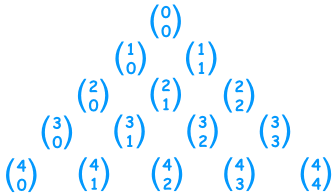 |
Putting It All Together
The last step is to put all the terms together into one formula.
But we are adding lots of terms together ... can that be done using one formula?
Yes! The handy Sigma Notation allows us to sum up as many terms as we want:
Sigma Notation
Now it can all go into one formula:

The Binomial Theorem
Use It
OK ... it won't make much sense without an example.
So let's try using it for n = 3 :

BUT ... it is usually much easier just to remember the patterns:
- The first term's exponents start at n and go down
- The second term's exponents start at 0 and go up
- Coefficients are from Pascal's Triangle, or by calculation using n!k!(n-k)!
Like this:
We may also want to calculate just one term:
Geometry
The Binomial Theorem can be shown using Geometry:
In 2 dimensions, (a+b)2 = a2 + 2ab + b2
In 3 dimensions, (a+b)3 = a3 + 3a2b + 3ab2 + b3
In 4 dimensions, (a+b)4 = a4 + 4a3b + 6a2b2 + 4ab3 + b4
(Sorry, I am not good at drawing in 4 dimensions!)
Advanced Example
And one last, most amazing, example:
Binomial Theorem is a very intriguing topic in mathematics due to its wide-ranging application. Before moving forth with its use, let me ask you a question? Do you remember what’s is (a + b)2 or (a-b)2? I guess most of you would have easily say (a+b)2 is a2 + b2 + 2ab and (a2 – b2) is a2 + b2 -2ab. But, what about (a + b)4? Okay, this is something you can still deduce. Let’s make it a little bit more complex, can you tell what the expansion for would be (a + b)7 or (7a – 5b)10. Now, I think it would not that simple to answer as you did earlier. Here’s something where the binomial Theorem can come into practice. And, in fact expansion of expressions such as is (a + b), (a-b)2 or (a + b)3 have all come through the use of Binomial Theorem. I hope that now you have understood that this article is all about the application and use of Binomial Theorem.
Many of you might be well acquainted with binomial Theorem specially those who had mathematics in their high school and those of you who know nothing about you will learn everything that’s necessary about it in this article. Let’s dig a deeper meaning in the nomenclature “Binomial Theorem/ Expansion”. Now Binomial means sum or difference of two terms and Binomial Expansion is the expansion of that sum of two terms. Since we have learnt what literally the meaning is, now is the time for some mathematics.
If both x and y are real and all n N then the Binomial Expansion of
(x + y)n = nC0 xn y0 + nC1 xn-1 y + nC2 xn-2 y2 + ….+ nCn-1 x yn-1 + nCn x0 yn
= ∑nr=0 nCr xn-r y
Therefore,
(x + y)2 = 2C0 x2 y0 + 2C1 x y + 2C2 x0 y2
= x2 + 2xy+ y2
(x + y)3 = 3C0 x3 y0 + 3C1 x2 y + 3C2 x1 y2 + 3C3 x0 y3
= x3 + 3x2y + 3xy2 + y3
(x + y)4 = 4C0 x4 y0 + 4C1 x3 y + 4C2 x2 y2 + 4C3 x y3 + 4C4 y4
= x4 + 4x3y + 6x2y2+ 4xy3 + y4
And so on.
Special Cases
- (x – y)n = nC0 xn y0 – nC1 xn-1 y + nC2 xn-2 y2 + ….+ (-1)n nCn x0 yn
- (1 + x)n = nC0 y0 + nC1 y + nC2 y2 + ….+ nCn-1 yn-1 + nCn yn
- (1 – x)n = nC0 – nC1 x + nC2 x2 + …. +(-1)n nCn xn
Tricks and Tips:
- The coefficients of (r + 1)th term in the expansion of (1 + x)n is nCr.
- The coefficient of xr in the expansion of (1 +x)n is nCr.
Important Points to remember:
- The positive integer n is called the index of the binomial.
- Number of terms in the expansion of (x + y)n is n + 1.
- In the expansion of (x + y)n, the power of x goes on decreasing by 1 and that of y goes on increasing by 1, therefore the sum of their powers should be equal to n.
- The binomial coefficients of the terms equidistant from the end and the beginning are equal.
- If n is odd, then the number of terms in (x + b)n + (x – b)n and in (x + b)n – (x – b)n are equal to (n + 1)/2.
- If n is even, then the number of terms in (x + b)n + (x – b)n are (n + 1)/2 and in (x + b)n – (x – b)n are n/2.
- xn + yn is divisible by x + y if n is odd as xn + yn = (x + y) (x^n-1 – x^n-2y + x^n-3y2 – …. + y^n-1)
- xn – yn is divisible by x + y if n is odd as xn + yn = (x – y) (x^n-1 + x^n-2y + x^n-3y2 + …. + y^n-1)
Formulas to remember
- nC0 = 1
- nC1 = n
- nC2 = n (n – 1)/2
- nC3 = n (n – 1) (n – 2)/ 3!
- ∑ni=0 (nCi) = 2nCn
- ∑ni=0 i (nCi)= n. 2n-1
- ∑ni=0 i (i – 1) … (i – k + 1) (nCi) = n (n-1)… (n – k + 1)
We can now move to some basic application of the above learned concept that can come in competitive exams such as CAT, XAT, IIFT, SNAP etc.
Example 1: The coefficient of x5 in the expansion of (1 + x2)5 (1 + x)4 is
a. 40
b. 50
c. -50
d. 60
Sol: (1 + x2)5 (1 + x)4 can be expanded and written as
(1+5C1 x + 5C2 x4 + 5C3 x6 + ….) (1 + 4C1 x + 4C2 x2 +…)
(1 + 5x2 + 10x⁴ +…) (1 +4x + 6x² + 4x³ + x⁴)
The terms giving x5 in the above product is (5x²) (4x³) + (10x⁴) (4x)
⇒(20 + 40) x5
⇒60x5
Hence, the coefficient is 60.
Example 2: If 7103 is divided by 25, then the remainder is
a. 20
b. 16
c. 18
d. 15
Sol: 7103 = 7 (7²)51 = 7(50 – 1)5
= 7 (5051 – 51C1 5050+ 51C2 5049 – … – 1)
= 7 (5051 – 51C1 5050+ 51C2 5049 -…) – 7 + 18 – 18
= 7 (5051 – 51C1 5050+ 51C2 5049 -…) – 25 + 18
= k + 18 (here, k is divisible by 25)
Therefore, remainder is 18.
Example 3: Larger of 9950 + 10050 and 10150is
a. 10150
b. 9950 + 10050
c. Both are equal
d. None of these
Sol: 10150 = (100 + 1)50
⇒(100 + 1)50 = 10050 + 50.10049 + [(50. 49)/ 2. 1]. 10048 +….
and 9950 = (100 – 1)50 = 10050 – 50.10049 + [(50. 49)/ 2. 1]. 10048 – ….
Subtracting both we get,
10150 – 9950 = 2(50. 10049 + [(50. 49. 48)/ 1. 2. 3]. 10047 + …)
= 10050 + 2. [(50. 49. 48)/ 1. 2. 3]. 10047 +…. > 10050
Hence, 10150 > 9950 + 1005
Example 4: The last digit of the number (32)32 is
a. 4
b. 6
c. 8
d. None of these
(32)32 = (2 + 3. 10)32
= 232 + 10k, where k
Therefore, last digit of 32)32 = last digit of 232
But 2² = 4, 2³ = 8, 2⁴ = 16, 25 = 32
Therefore, 232 = (25)6. 2² = (32)6. 4 = (2 + 30)6. 4
= (26 + 10r). 4, r
Hence, last digit of 32)32 = last digit of 232 = last digit of 26. 4= last digit in 4 x 4 = 6.
Few more concepts related to Binomial Expansion
Method of Finding Independent term or constant term.
i.) Write down the general term in the expansion of (x + a)ne. (r + 1)th term.
⇒ Tr+1 = nCr xn-r ar
ii.) Separate the constants and variables. Also, group them separately.
iii.) Since, we need them to find independent of x in the given binomial expansion, equate to zero the index of x and accordingly we’ll get the value of r for which there exists a term independent of x in the expansion.
Method of Finding Greatest Term in the expansion of (1 + x)n
Method 1
i.) Let Tr be the greatest term.
ii.) Find Tr-1, Tr, Tr+1, from the given expansion.
iii.) Put Tr/ Tr+1 ≥ 1 and Tr/ Tr-1 ≥ This will give an inequality from where value or values of r can be obtained.
iv.) Then, find the rth term Tr, which is the greatest term.
Method 2
i.) Find the value k = [(n + 1) |x|] / 1 + |x|
ii.) If k is an integer, then Tk and Tk+1 are equal and both are greatest term.
iii.) If k is not an integer, then T(k) + 1 is the greatest term, where (k) is the greatest integral part of k
Tricks and Tips:
- To find the greatest term in the expansion of (x + y)n, write (x + y)n = xn (1 + y/x)n and then find the greatest term in (1 + y/x)n.
Middle term in the Binomial Expansion:
The middle term in the binomial expansion of (x + y)n depends upon the value of n.
i.) If n is even, then there is only one middle term i.e. (n/2 + 1) th term.
ii.) If n is odd, then there are two middle terms i.e. (n+1/ 2) th term and (n + 3)/ 2 th term.
Tricks and Tips:
- When there are two middle terms in the expansion, their binomial coefficients are equal.
- Binomial coefficient of the middle term is the greatest binomial coefficient.
Some more applications
Example 5: The greatest term (numerically) in the expansion of (2 +3x)9, when x = 3/2, is
a.) (5 x 311) /2
b.) (5 x 313) /2
c.) (7 x 313) /2
d.) None of these.
Sol: (2 +3x)9 = 29 (1 + 3x/2)9 = 29 (1 + 9/4)9
Therefore, m = | [x (n + 1)]/ (x + 1) |
= | (9/4) (9 + 1)/ (9/4) + 1| = 90/ 13 = 6 12/13 ≠ Integer
= The greatest term in the expansion is T[m] + 1 = T6 + 1 = T7
Hence, the greatest term = 29. T7
= 29. T6 + 1 = 29. 9C6 (9/4)6
= 29. 9C6 (9/4)6 = 29. (9.8.7)/ 1.2.3. 313/ 212 = (7 x 313) /2
Example 6: If n is a positive integer, then (√3 + 1)2n – (√3 – 1)2n is
a.) An irrational number
b.) An odd positive number
c.) An even positive number
d.) A rational number other than positive integers.
Sol: (√3 + 1)2n – (√3 – 1)2n = 2[ 2nC1 (√3)2n – 1 + 2nC3 (√3)2n – 3 + 2nC5 (√3)2n – 5 +…]
= which is an irrational number.
I hope the above examples have given you a fair idea about such multiple usages of the Binomial Expansion. And, these are only a few sums and there can be a thousand others in which might not directly give you hint about the effectiveness of solving this expansion in problem solving. These applications can only be known and mastered with practice only. So, keep practicing











![(1 + 1/n)^n = Sigma k=0 to n of [ (n choose k) by 1^(n-k) by (1/n)^k ]](https://www.mathsisfun.com/algebra/images/binomial-theorem-e.gif)
![Sigma k=0 to n of [ (n choose k) by (1/n)^k ]](https://www.mathsisfun.com/algebra/images/binomial-theorem-e2.gif)

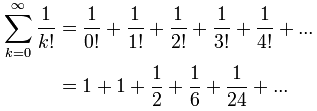








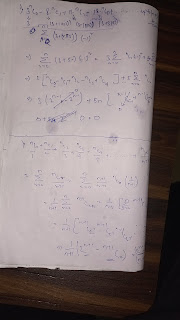













































Thanks helped me a lot
ReplyDelete